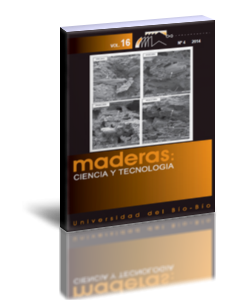Ver ítem
- xmlui.general.dspace_homeCentros Regionales y EEAsCentro Regional MisionesEEA MontecarloArtículos científicosxmlui.ArtifactBrowser.ItemViewer.trail
- Inicio
- Centros Regionales y EEAs
- Centro Regional Misiones
- EEA Montecarlo
- Artículos científicos
- Ver ítem
Efecto del raleo sobre las propiedades anatómicas de la madera de Pinus taeda = Effect of thinning on the anatomical properties of Pinus taeda wood
Resumen
El raleo tiene implicancias económicas y técnicas para producción forestal y para la actividad
industrial. El objetivo del estudio fue determinar la influencia de la intensidad de raleo sobre las
propiedades anatómicas de la madera. Se trabajó con muestras tomadas a 1,30 m de altura, de 24 árboles
proveniente de un ensayo de raleo en Pinus taeda de 20 años de edad, intervenido a los 3 años, con
remoción del 0%, 50%, 75% y 87,5% de las plantas de la
[ver mas...]
El raleo tiene implicancias económicas y técnicas para producción forestal y para la actividad
industrial. El objetivo del estudio fue determinar la influencia de la intensidad de raleo sobre las
propiedades anatómicas de la madera. Se trabajó con muestras tomadas a 1,30 m de altura, de 24 árboles
proveniente de un ensayo de raleo en Pinus taeda de 20 años de edad, intervenido a los 3 años, con
remoción del 0%, 50%, 75% y 87,5% de las plantas de la densidad inicial de plantación (1960 árboles/
ha). Se midieron diámetro a la altura de pecho, altura total, diámetro en la base de la copa viva y altura
a la base de la copa viva, longitud de traqueidas, espesor de pared celular y ángulo microfibrilar. La
longitud de traqueidas fue mayor en el tratamiento con 87,5% de raleo. Los tratamientos con 0% y 50%
de raleo favorecieron la obtención de mayores valores de espesor de pared y menores valores de ángulo
microfibrilar. Se concluyó que esta práctica silvícola altera a las propiedades anatómicas de la madera
de Pinus taeda y que la longitud de traqueidas está fuertemente relacionada con el tamaño del árbol y
con la longitud de la copa verde
[Cerrar]
Thinning has technical and economic implications for both, forest production and industrial activity.
The aim of this study was to determine the effect of thinning intensity on the anatomical properties of
pine wood. Samples were taken at 1.30 m height, from 24 Pinus taeda trees of 20 years old, coming
from a thinning treatment. The plantation was intervened at 3 years, with removal of 0%, 50%, 75% and
87,5% of the trees from the initial density (1960
[ver mas...]
Thinning has technical and economic implications for both, forest production and industrial activity.
The aim of this study was to determine the effect of thinning intensity on the anatomical properties of
pine wood. Samples were taken at 1.30 m height, from 24 Pinus taeda trees of 20 years old, coming
from a thinning treatment. The plantation was intervened at 3 years, with removal of 0%, 50%, 75% and
87,5% of the trees from the initial density (1960 trees/ha). The evaluated variables were: diameter at
breast height, total height, diameter on the base of the live crown, height at base of live crown, tracheid
length, cell wall thickness and microfibril angle. The tracheid length was higher in 87.5% thinning
treatment. Treatments with 0 % and 50% thinning have favored the obtaining of higher values of cell
wall thickness and lower values of microfibril angle. Results suggest that this silvicultural practice alters
the anatomical properties of Pinus taeda wood and that tracheid length is strongly related to tree size
and length of live crown.
[Cerrar]

Autor
Winck, Rosa Angela;
Fassola, Hugo Enrique;
Area, Maria Cristina;
Fuente
Maderas, ciencia y tecnología [Concepión, Chile] 17 (2) : 391-406. (abr. 2015)
Fecha
2015
ISSN
0717-3644
0718-221X
0718-221X
Formato
pdf
Tipo de documento
artículo
Palabras Claves
Derechos de acceso
Abierto
 Excepto donde se diga explicitamente, este item se publica bajo la siguiente descripción: Creative Commons Attribution-NonCommercial-ShareAlike 2.5 Unported (CC BY-NC-SA 2.5)
Excepto donde se diga explicitamente, este item se publica bajo la siguiente descripción: Creative Commons Attribution-NonCommercial-ShareAlike 2.5 Unported (CC BY-NC-SA 2.5)


